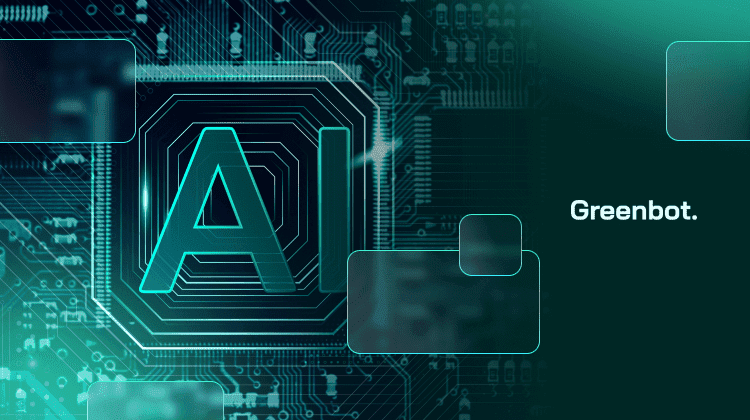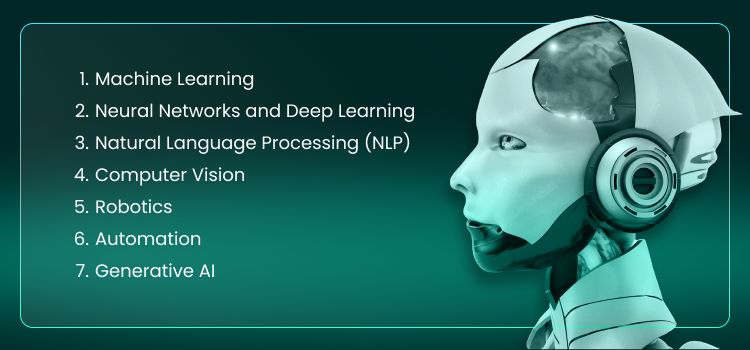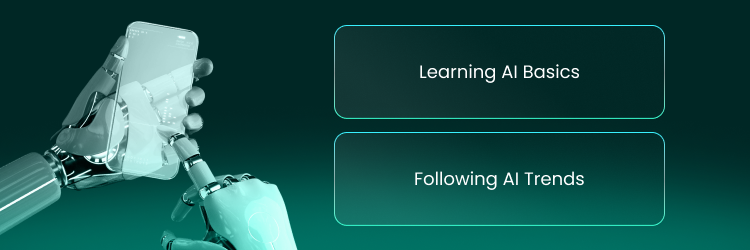
What is AI? Artificial Intelligence (AI) refers to machines imitating human intelligence. It performs tasks like understanding language, solving problems, and recognizing patterns. This definition of AI highlights its role as a cornerstone of modern technology. Artificial intelligence technology powers innovations such as virtual assistants, self-driving cars, and personalized recommendations. Its impact reshapes industries.
Here is a comprehensive article on AI.
Understanding the Definition of AI
AI is a branch of computer science that enables machines to mimic human intelligence. This includes problem-solving, learning from experience, and adapting to new information. Unlike traditional software, AI systems analyze data and improve over time. This makes them versatile and capable of addressing complex problems using technologies like machine learning (ML) and large language models (LLMs).
The core principles of AI technology include data processing, algorithms, and adaptability. For example, Netflix uses AI to analyze user preferences and suggest personalized content. These systems work with large datasets. They improve over time using machine learning to boost accuracy and improve user experiences.
Artificial intelligence has advanced significantly since the 1950s. Early systems focused on simple, logic-based tasks. Today, technologies like Generative AI create images, music, and text. These innovations transform industries such as entertainment and healthcare. However, they also raise concerns about bias, accountability, and fairness.
A Brief History of Artificial Intelligence
The concept of artificial intelligence began in the 20th century. In 1950, Alan Turing introduced the Turing Test in his paper Computing Machinery and Intelligence. This test measured whether a machine can mimic the human brain. Turing’s work laid the foundation for modern AI technology. It also established him as a key pioneer in the field.
In 1956, John McCarthy coined the term “artificial intelligence” at the Dartmouth Conference. This event was the first official meeting dedicated to AI.
McCarthy, Herbert Simon, and Allen Newell created the Logic Theorist, the first AI program. In 1967 Frank Rosenblatt developed the Perceptron, an early neural network model. The Perceptron mimicked human learning through trial and error. It paved the way for today’s machine learning systems.
AI advanced rapidly in the 1990s. In 1997, IBM’s Deep Blue defeated chess champion Garry Kasparov. This milestone showcased AI’s ability to master strategic games. In the 2010s, Google DeepMind’s AlphaGo defeated human champions in the game of Go. This highlighted the potential of deep learning. Today, technologies like OpenAI’s GPT create text, images, and other content.
Types of Artificial Intelligence
Narrow AI
Narrow AI, or weak AI, focuses on performing specific tasks efficiently. Examples include virtual assistants like Siri and Alexa or recommendation systems on Netflix. These systems excel in repetitive tasks but cannot adapt to new challenges. This limitation defines AI technology in its narrow scope.
In healthcare, narrow AI analyzes medical images and helps diagnose diseases. It also powers chatbots to handle customer queries. These applications show the value of AI in solving practical problems. However, narrow AI is limited to its programmed functions.
General AI
General AI, or strong AI, refers to machines capable of human-like intelligence. Unlike narrow AI, it can learn and adapt to new tasks without additional programming. Achieving general AI is a primary goal of AI technology research.
Though still theoretical, general AI could revolutionize industries. It could solve complex problems and automate creative tasks. However, its development raises ethical concerns, such as accountability for machine-made decisions. Discussions often focus on ensuring AI’s evolution aligns with human values and societal needs.
Superintelligent AI
Superintelligent AI refers to machines surpassing human intelligence in all aspects. It could solve critical global issues like climate change or disease eradication. However, it raises serious concerns about losing control of advanced systems. These discussions highlight the importance of regulating AI technology responsibly.
How Does AI Work?
Artificial intelligence (AI) works by analyzing data and identifying patterns. It uses these patterns to make decisions or predictions. AI systems rely on AI technology to improve and adapt over time. The core components of AI include algorithms, data processing, and learning mechanisms. These elements are essential for performing tasks that require intelligence.
Core Components of AI
- Algorithms: Algorithms are rules that help AI analyze data and solve problems. For example, streaming platforms use algorithms to recommend content. They suggest it based on user preferences.
- Data Processing: AI depends on data to function effectively. The process involves collecting, cleaning, and organizing data for analysis. In healthcare, AI processes medical records to help diagnose diseases. Without efficient data processing, AI models cannot deliver accurate results.
- Learning Mechanisms: Learning enables AI to adapt and improve over time. Supervised learning trains models with labeled data. Unsupervised learning finds patterns in raw datasets. Inspired by trial-and-error methods, reinforcement learning helps AI refine its decision-making processes. These mechanisms form the foundation of what is AI technology.
How AI Performs Tasks
AI combines these components to complete tasks efficiently. For example, in image recognition:
- Data is processed to understand visual patterns.
- Algorithms identify objects in the image.
- Learning mechanisms improve accuracy by refining predictions with each iteration.
This shows how AI systems adapt and excel in tasks, like image analysis and voice recognition.
Programming Focus Areas
AI programming revolves around four critical skills:
- Learning: Acquiring and processing data using algorithms.
- Reasoning: Choosing the most suitable algorithm for specific tasks.
- Self-Correction: Continuously improving results based on feedback.
- Creativity: Using neural networks and other methods to generate content, like images, music, or text.
One trending innovation is Generative AI, which creates realistic text, visuals, and even music. It shows AI’s capabilities. But, it raises ethical questions about bias, misuse, and accountability.
What Are Examples of AI Technology, and How Is It Used Today?
AI technology improves life by automating tasks and boosting efficiency. It also enables new solutions. Below are key areas where AI is applied, with specific real-world examples.
Machine Learning
Machine Learning (ML) is a branch of AI that enables machines to learn from data without explicit programming. It identifies patterns and makes predictions based on large datasets. ML is used in fraud detection, personalized recommendations, and predictive analytics.
Techniques:
- Supervised Learning: Trains models with labeled data for tasks like email spam detection.
- Unsupervised Learning: Finds patterns in unlabeled data, such as customer segmentation.
- Reinforcement Learning: Mimics trial-and-error learning, as seen in robotics navigation.
Real-World Examples:
- Netflix: Recommends shows based on user behavior.
- Fraud Detection Systems: Monitors banking transactions for anomalies.
- Google Translate: Improves translations using learning algorithms.
Neural Networks and Deep Learning
Neural networks mimic the human brain’s structure through interconnected nodes. Deep learning, a subset of neural networks, analyses data through multiple layers. It is known to power breakthroughs in image recognition, speech processing, and diagnostics.
Real-World Examples:
- Image Recognition Tools: Identify objects in photos or videos.
- Voice Assistants: Siri and Alexa process spoken commands.
- Healthcare Diagnostics: AI detects diseases like cancer in X-rays or MRIs.
Natural Language Processing (NLP)
Natural Language Processing (NLP) enables AI to understand, interpret, and generate human language. It is the backbone of chatbots, translation tools, and voice assistants. It improves communication between humans and machines.
Real-World Examples:
- Speech Recognition: Google Voice transcribes spoken words into text.
- Chatbots: Zendesk automates customer support.
- Language Translation: Google Translate bridges communication gaps.
Advanced NLP models like ChatGPT offer several benefits to businesses. They can draft emails, generate content, and interact with customers efficiently.
Computer Vision
Computer Vision enables AI to analyze and interpret visual data such as images and videos. This technology mimics human sight and has healthcare, transportation, and security applications. It is vital for tasks like object detection and facial recognition.
Real-World Examples:
- Medical Imaging: AI detects abnormalities in CT scans, aiding doctors.
- Autonomous Vehicles: Self-driving cars, like Tesla, recognize traffic signs and obstacles.
- Security Systems: AI-powered surveillance systems identify threats in real-time.
Computer vision is also getting more precise. It’s now vital in healthcare and logistics.
Robotics
Robotics combines AI with mechanical systems to perform tasks autonomously. Robots are widely used in industries for repetitive or hazardous jobs. They improve efficiency and safety while reducing human effort in critical operations.
Real-World Examples:
- Space Exploration: NASA’s Perseverance Rover collects data on Mars.
- Deep-Sea Missions: Robots analyze underwater ecosystems.
- Factory Automation: Robots sort and assemble items on production lines.
Robots adapt to dynamic environments with AI, reducing human effort and increasing efficiency.
Automation
Automation streamlines repetitive tasks by combining AI with workflow management. It enhances efficiency and reduces errors in loan approvals and inventory management. Businesses rely on automation to focus on strategic goals.
Real-World Examples:
- Banking: Automates loan approvals by analyzing applicant data.
- Retail: Optimizes inventory management for better stock control.
- Customer Service: AI chatbots handle queries, allowing human agents to focus on critical tasks.
Automation will enable businesses to focus on strategic goals while leaving routine tasks to AI systems.
Generative AI
Generative AI creates new content, such as text, images, music, and videos. It uses advanced machine learning models to produce highly realistic outputs. Generative AI is popular in creative industries and content creation.
Real-World Examples:
- ChatGPT: Produces human-like conversations and text.
- DALL-E: Creates unique images from text prompts.
- MidJourney: Generates creative visual art and design.
Key Applications of Artificial Intelligence
AI is transforming industries and everyday life through diverse applications. It powers healthcare advances and personalized consumer experiences. Below, we explore some of the most impactful areas where AI makes a difference.
AI in Everyday Life
AI has seamlessly integrated into daily life, enhancing convenience and personalization.
- Virtual Assistants: AI tools like Alexa, Siri, and Google Assistant help manage schedules, answer queries, and control smart devices.
- Personalized Recommendations: Netflix and Amazon use AI to suggest content and products based on user preferences.
- Smart Devices: AI powers smart thermostats and security systems, optimizing energy use and home safety.
AI’s role in everyday life simplifies routine tasks, offering tailored experiences for users.
AI in Business and Industry
AI improves efficiency, decision-making, and customer engagement in various industries.
- Data Analysis: Tools like Tableau use AI to analyze large datasets and predict trends.
- Customer Service: Chatbots and AI-driven systems offer instant responses and support, enhancing user experiences.
- Process Automation: AI automates repetitive tasks, like invoice processing and supply chain management.
Businesses leverage AI to save time, cut costs, and improve productivity.
AI in Healthcare
Healthcare relies on AI for better patient outcomes and innovative medical solutions.
- Diagnostic Tools: AI platforms such as IBM Watson Health assist in early and accurate diagnosis.
- Virtual Health Assistants: Apps like Babylon Health provide patients with symptom analysis and health advice.
- Predictive Analytics: AI predicts disease outbreaks, aiding prevention and resource allocation.
AI empowers healthcare professionals to deliver precise, data-driven care.
Benefits and Challenges of AI
AI offers significant benefits but also presents challenges that need careful consideration. Below, we explore both aspects to provide a balanced view.
Advantages of AI
AI has transformed industries. It can improve processes and outcomes.
- Increased Efficiency: AI automates tasks, reducing time and effort in various operations.
- Precision in Data Analysis: AI analyzes vast datasets accurately, uncovering valuable insights.
- Automation of Repetitive Tasks: Routine tasks like data entry and scheduling are streamlined through AI.
- Enhanced Decision-Making: AI uses data insights to support strategic, evidence-based decisions.
- Cost Savings: Automation reduces operational costs by minimizing human error and resource waste.
AI boosts productivity and accuracy. It helps industries get better results with fewer resources.
Challenges of AI
Despite its benefits, AI poses several challenges. These include:
- Ethical Concerns: Issues like privacy breaches and misuse of AI raise moral questions.
- Job Displacement: Automation may lead to job loss in roles replaced by AI-driven systems.
- Algorithmic Biases: AI systems can inherit biases from training data, leading to unfair outcomes.
- Regulatory Hurdles: Governments and organizations struggle to create appropriate laws for AI governance.
- Dependence on Data: AI performance heavily depends on data quality and availability.
The Future of Artificial Intelligence
The future of AI holds immense potential to transform industries and everyday life. AI technology is expected to enhance personalization, improve automation, and enable smarter decision-making. Developments like generative AI and autonomous systems could redefine creativity and logistics. However, it is crucial to understand “what artificial intelligence” is. Its definition is evolving as technology advances.
AI will likely create opportunities across sectors, from healthcare to finance. Predictive analytics could optimize medical treatments, while AI-driven insights might reshape financial markets. Businesses adopting AI technology can streamline processes and boost efficiency. Yet, addressing questions like “how does AI work?” is key to leveraging these benefits effectively and responsibly.
Despite opportunities, risks have to be managed as AI evolves. Ethical concerns, data privacy issues, and algorithmic biases require attention. Policymakers must also balance innovation with regulation to avoid concerns such as job loss.
Collaboration between industries and governments is essential to prepare for AI’s future. Establishing ethical frameworks and investing in AI education can promote responsible use. Knowing “what is AI technology” lets people use it and reduce risks. This ensures a balanced approach to innovation.
AI and Ethics
Ethical frameworks, from fairness to accountability, are essential to ensure AI benefits everyone.
The Ethical Debate Around AI
AI development requires clear ethical guidelines to prevent misuse. Issues like privacy, transparency, and accountability are central to these discussions. Without regulation, AI could be misused for harmful ends such as surveillance and discrimination. Ethical frameworks ensure responsible innovation while protecting societal values.
Governments and organizations must collaborate to create policies guiding AI’s use. Standards for fairness and data security are crucial to prevent negative outcomes. Ethical guidelines can help balance tech progress with society’s well-being.
Bias in AI
Algorithmic bias occurs when AI systems produce unfair outcomes. Bias often stems from flawed or incomplete training data. For example, hiring algorithms favour certain demographics. This leads to inequality. Similarly, facial recognition systems have shown inaccuracies when identifying people from minority groups.
Bias in AI has far-reaching implications. It can reinforce harmful stereotypes and create systemic disadvantages. Addressing bias requires the use of diverse datasets, conducting regular audits, and designing algorithms inclusively. These steps can help ensure that AI systems operate fairly and equitably.
How to Stay Informed About AI
AI is rapidly evolving, influencing multiple industries and daily life. To stay informed, learn the basics. Then, follow the latest trends from reputable sources.
Learning AI Basics
For beginners, understanding the fundamentals of AI is essential. Online platforms like Coursera (e.g., Machine Learning by Andrew Ng) and edX offer beginner-friendly courses. These courses cover topics like machine learning algorithms and artificial neural networks. They also use historical data to teach pattern recognition and predictive modeling concepts.
Books like Artificial Intelligence: A Guide to Intelligent Systems by Michael Negnevitsky provide detailed insights into AI principles. Tools like Google’s Teachable Machine offer interactive learning. They enable users to explore deep neural networks and gain hands-on experience. Beginners can train models to improve their AI skills and knowledge.
Following AI Trends
Staying updated on AI advancements is vital in today’s fast-changing world. Publications like MIT Technology Review and OpenAI’s blog offer insights into new topics. These include areas such as artificial general intelligence and AI ethics. These trusted sources help readers understand the latest breakthroughs and their implications.
Engaging with online communities like Reddit’s r/MachineLearning fosters knowledge exchange. These platforms allow AI enthusiasts and professionals to share ideas and learn together. Participating in webinars hosted by industry experts also offers valuable insights. These resources help individuals keep up with AI’s growing impact across various sectors.
FAQs About Artificial Intelligence
What Is AI in Simple Terms?
AI is the simulation of human intelligence in machines programmed to think and learn like humans. This includes tasks such as problem-solving, understanding language, and recognizing patterns.
What Are the Main Types of AI?
AI is categorized into three types:
- Narrow AI: Designed for specific tasks.
- General AI: Possesses human-like intelligence across various tasks.
- Superintelligent AI: Surpasses human intelligence.
How Is AI Different from Machine Learning?
Machine learning (ML) is a subset of AI. AI includes all intelligent systems, such as rule-based programs and machine learning models. ML focuses on enabling machines to learn from data. For instance, Netflix uses ML to recommend shows based on viewing history.
How Does AI Benefit Society?
AI improves healthcare with faster diagnoses. In business, it boosts productivity through automation. It also makes life easier with personalized app recommendations, like on Netflix and Amazon.
What Are the Risks of AI?
AI poses risks such as ethical concerns and job displacement caused by automation. Algorithmic biases can lead to unfair outcomes. Misuse of AI in surveillance also adds another layer of risk.
What is AI? Conclusion
Artificial Intelligence (AI) is transforming how we live and work by enabling machines to mimic human intelligence. Through core technologies like machine learning, neural networks, and natural language processing, AI powers applications that automate tasks, analyze data, and generate creative content. While AI drives innovation across industries, it also raises ethical concerns, emphasizing the need for responsible development and use.






















